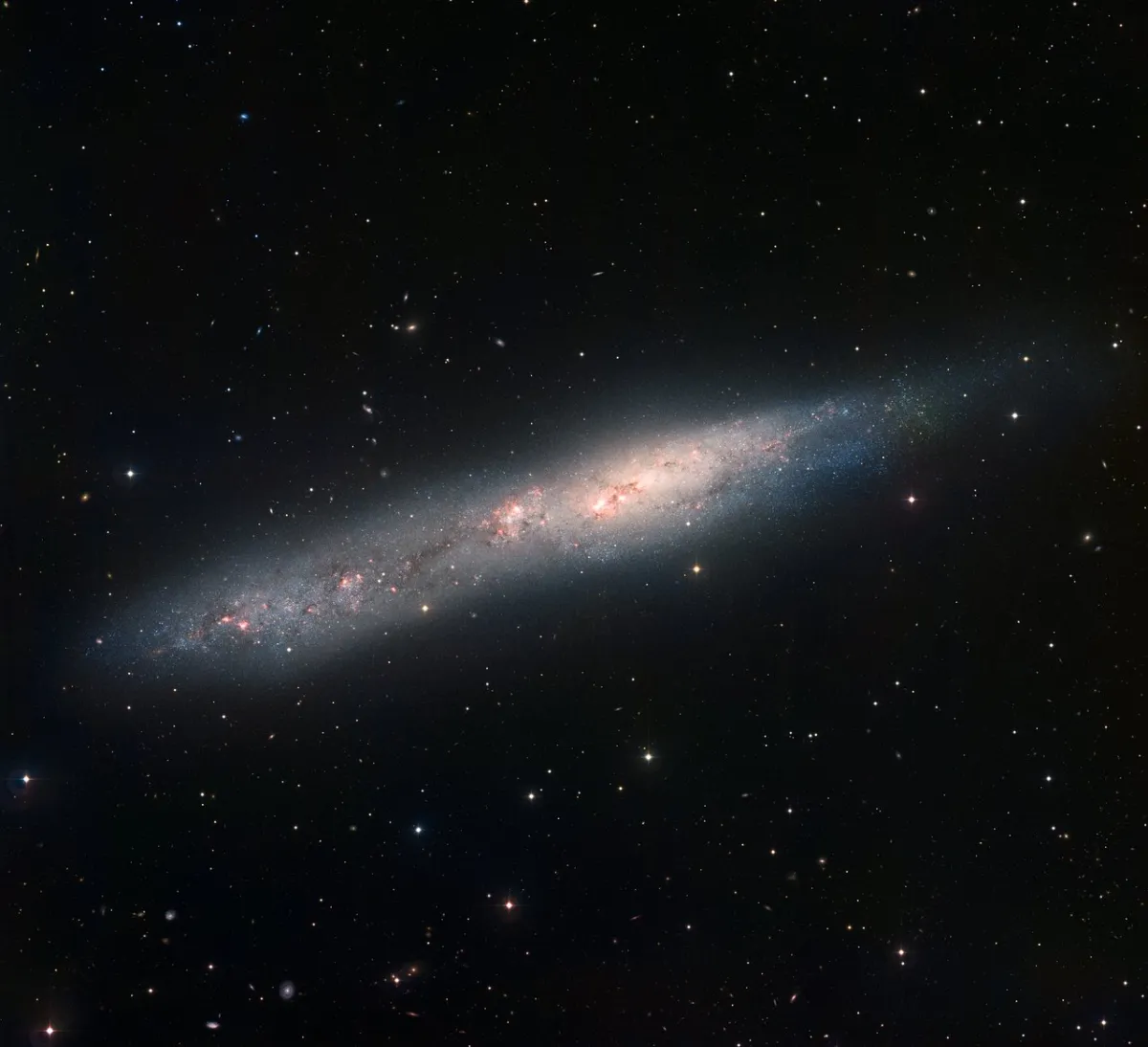Galaxy NGC 55

History
The galaxy NGC 55 was discovered by James Dunlop on 7 July 1826 while observing from Parramatta, New South Wales, using his 9-inch f/12 speculum reflector. He listed it as Δ 507 and described it as follows: «A beautiful long nebula, about 25' in length; position north preceding, and south following, a little brighter towards the middle, but extremely faint and diluted to the extremities. I see several minute points or stars in it, as it were through the nebula: the nebulous matter of the south extremity is extremely rare, and of a delicate bluish hue. This is a beautiful object.» [50]
John Herschel observed this galaxy from South Africa and listed it as h 2315. He recorded three observations. Sweep 488 on 4 September 1834: «Bright; very large; very much elongated in a long irregular train, the preceding end being much the brightest. Whole length = 1.5 diameter of field, or 22' The nucleus is either a double star or a much more sharply terminated nebulous mass, elongated in a different position (146.5°) from that of the nebula (109.8°).» Sweep 638 on 23 October 1835: «Very bright; very large; very much elongated; at least 25' long and 3' broad. The following part is faint, the preceding and shorter trinuclear the 2d, nucleus taken. A strange object.» Sweep 737 on 4 October 1836: «Very bright, very large; a very long irregular crooked ray with 3 nuclei, the second of which appears to consist of stars.» [11]
On 23 September 1897 Lewis Swift observed NGC 55 using the 16-inch Clark refractor at Warner Observatory, Rochester. He reported the eastern section as a new object XI-2: «eeeF; vL; eE; close f NGC 55; f of 2.» He also added following footnote: «This with its associated companion is a remarkable nebula. I am undecided as to whether it is all one, or consisting of two, the preceding half very bright, very large exceedingly elongated as Sir John Herschel describes it, and the following half exceedingly exceedingly faint, very large, exceedingly elongated, partly overlapping the other. If single it is curved, if double are inclined to each other. I am inclined to think they are two distinct nebule, one reason being that the brighter ends sharply, which would be improbable if the brighter merged into the fainter. The brighter was discovered by Dunlop, but he could not have seen the fainter. As Sir John Herschel does nmot mark it with a sign as being a remarkable objects, lends plausibility to the idea that it was not seen even by him.» As a result, Dreyer assigned it as IC 1537. [670]
Physical Properties
NGC 55 is classified as a Magellanic-type galaxy, a category named after the Large Magellanic Cloud. These galaxies typically feature a single spiral arm and represent an intermediate form between irregular and dwarf spiral galaxies. Morphologically, NGC 55 bears a strong resemblance to the Large Magellanic Cloud, though it is smaller in size and viewed edge-on from Earth. Its distance is estimated to be approximately 6.5 million light-years away. [261]
| Name | RA | Dec | Type | bMag | vMag | B-V | SB | Dim | PA | z | D(z) | MD | Dreyer Description | Identification, Remarks |
|---|---|---|---|---|---|---|---|---|---|---|---|---|---|---|
| NGC 55 | 00 15 08.0 | -39 13 10 | Gx (SBm) | 8.4 | 7.9 | 0.5 | 13.4 | 31.2 × 5.9 | 108 | 0.000430 | 1.82 | 1.940 | vB, vL, vmE, triN | h 2315; GC 27; ESO 293-50; MCG -7-1-13 |
| IC 1537 | 00 15 49.5 | -39 15 39 | GxyP | 15.0 | 0.5 | 1.940 | eeF, vL, vmE, 55 np | ESO 294-1; part of N 55 |
Finder Chart
With a declination of -39° in the constellation Sculptor the galaxy NGC 55 is not visible from central Europe. Because the earth is round, for each 111 km more south you travel the galaxy rises 1° higher above the southern horizon. On 28 September it in opposition with the Sun and is therefore highest in the sky at local midnight.
